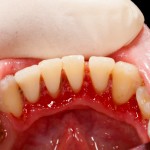
Non-surgical periodontal treatment is the mainstay of treatment for the management of periodontitis. A number of adjunctive treatments have been used to improve outcomes including, local and systematic antibiotics and photodynamic therapy. It has been suggested that boric acid may be beneficial as boron compounds have antimicrobial, anti-inflammatory and immune regulatory effects and beneficial effects have been seen in animal models.
The aim of this review was to assess the efficacy of boric acid as an adjunct to non-surgical periodontal therapy, compared to placebo, in patients with periodontitis.
Methods
Searches were conducted in the PubMed, Cochrane Central Register of controlled trials (CENTRAL) and Embase databases. Randomised controlled trials (RCTs) with at least 6 months duration and published in English were considered. Two reviewers independently screened the studies with data extraction being undertaken by a single reviewer and verified by a second reviewer. Risk of bias was assessed using the Cochrane domains-based approach. Meta-analyses were conducted for treatment outcomes at 3 months and 6 months, using mean difference (mm) with standard deviation.
Results
- 4 RCTs (3 parallel, 1 split mouth) involving a total of 65 patients were included.
- 3 studies were conducted in India, 1 in Turkey.
- All the studies reported on probing pocket depth (PPD) and clinical attachment level (CAL)
- 2 studies were considered to be at low risk of bias one at unclear risk and one at high risk.
- Meta-analysis (3 studies) found a statistically significant improvement in PPD and CAL at 6 months but not 3 months.
| Probing pocket depth mm (95%CI) | Clinical attachment level mm (95%CI) | |
| 3 months | 0.58 (−0.03 to 1.19) | 0.62 ( −0.07 to 1.32 mm) |
| 6 months | 1.18 (0.97 to 1.40) | 1.24 (0.89 to 1.58 mm) |
Conclusions
The authors concluded: –
Boric acid as an adjunct to non-surgical periodontal therapy may improve treatment outcomes
Adjunctive boric acid at 0.75% concentration does not increase the risk of adverse events, as compared with placebo
There is a paucity of literature surrounding the subject, necessitating more high-quality, adequately powered, randomized controlled trials
Comments
The authors have searched 3 major databases although restricting the inclusions to English language papers may have excluded relevant studies. All 4 studies used 0.75% boric acid concentration 3 in gel format the other as an irrigant solution. It included studies were all small with the largest sample size being 25 patients (range 15-25). Because of the limited number of small studies included in this review the findings should be considered very cautiously. As the authors note, boric acid has a low pH so has protentional for adverse effects on the tooth structure and may induce hypersensitivity. However adverse effects are not specifically reported. Further high-quality well conducted and reported trials of adequate size are needed to confirm whether there is any beneficial effect from the adjunctive use of boric acid during non-surgical periodontal treatment.
Links
Primary Paper
Bashir NZ, Krstic M. Boric acid as an adjunct to periodontal therapy: A systematic review and meta-analysis. Int J Dent Hyg. 2021 Jan 29. doi: 10.1111/idh.12487. Epub ahead of print. PMID: 33513275.
Other references
Dental Elf – 27th Nov 2020
Photodynamic therapy as an adjunct to non-surgical periodontal treatment
Dental Elf – 25th Nov 2020
Periodontitis: Locally delivered antimicrobials as an adjunct to non-surgical treatment
Dental Elf – 23rd Nov 2020
Periodontitis: Systemic antimicrobials as an adjunct to non-surgical treatment
